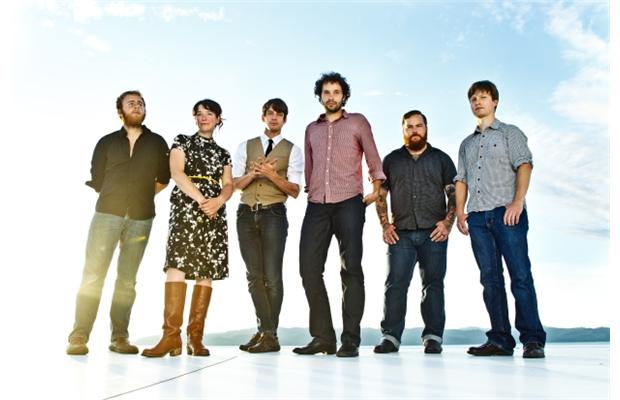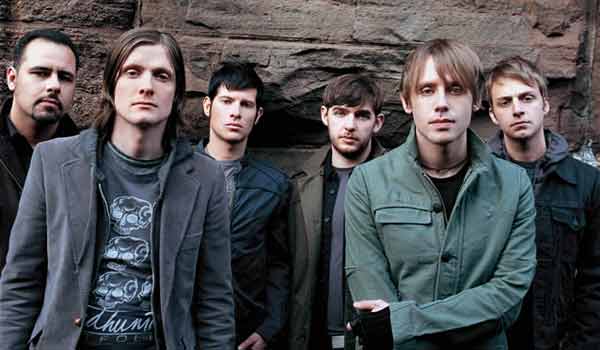Videos by American Songwriter
Four years ago, coming off a high-profile tour opening for R.E.M and Bruce Springsteen and a few months away from his landmark I’m Wide Awake, It’s Morning album, Conor Oberst was the angry young man of indie rock and ready for any question I threw at him. Politics, religion, his songwriting process-it was all fair game, but there was one question that brought the interview to a halt. I asked him how he felt about being compared to Bob Dylan.

Four years ago, coming off a high-profile tour opening for R.E.M and Bruce Springsteen and a few months away from his landmark I’m Wide Awake, It’s Morning album, Conor Oberst was the angry young man of indie rock and ready for any question I threw at him. Politics, religion, his songwriting process-it was all fair game, but there was one question that brought the interview to a halt. I asked him how he felt about being compared to Bob Dylan.
“I think that’s a ridiculous comparison, and totally premature,” he said firmly. “It’s nice that people think that, I suppose,” he sighed after a thoughtful pause. “But I don’t see it.” He might be the only one. Both earned their reputations for their words, scruffy kids from the Midwest whose songs resonated with wisdom that seemed to be channeled from the ghosts of sages and prophets past. Both found their greatest fame after moving to New York City, eventually ending up critical darlings that remained just below the surface of mainstream appeal. And, as both entered their late 20s, fully grown and burned out from the glare of a generation who wanted a spokesperson, both retreated to the countryside to write songs that turned away from a troubled world, escaping into an inner landscape of fantasies and fixations. Dylan went north to Big Pink with The Band; Oberst went across the border to a small rural town in Mexico with the Mystic Valley Band.
“It wasn’t a studio at all,” Oberst says of the villa-style hotel where he and a small collection of handpicked players spent six weeks in January and February of 2008. “It was up in the mountains above the town. We turned the biggest room into the studio, and then we all lived in the other ones and had a communal kitchen and shared meals together and hung out. We did a lot of the recording outside on the porch, and it really just is what it is. We didn’t put a lot of effort into manipulating the sounds. It was just capturing them as they happened. I was surprised, because when we got there, we were a little worried, because it’s not what people would recommend when they talk about recording. Drums and things tend to sound crazy in a room like that, and I mean crazy in a bad way. But it worked out good, because the tape machine compresses and dulls the sound, because it’s an older machine. If the sound started out bright, by the time they went through the mics and onto the tape, they were toned down and sounded warm and nice.”
That approach couldn’t be more at odds with Cassadaga, the 2007 Bright Eyes album which necessitated Oberst and his bandmates to shuttle around the United States looking for the perfect studio and side players to create their sprawling ode to American mysticism and impending doom. But as Oberst has often thrived through drawing his listener into the intimacy of the room and the middle of his narratives, Cassadaga was so multifaceted and carefully manicured that it could occasionally distract from the core of Oberst’s writing. Just like Dylan did forty years earlier, Oberst and his bandmates left a world torn apart by war and political upheaval and built a temporary utopia, losing themselves in songs whose creation was its own reward.
“We were down there for about six weeks, but we weren’t recording the whole time. It was a very leisurely schedule,” he explains. “My policy was that if anyone was restless or bored to just stop and hang out. We were in this town called Tepoztlan, which is two hours away from Mexico City, so on the weekends we would just go into the city and hang out. The town itself is really small, but we’d walk in there almost every day and hang out. Other times, we’d just sit by the fire. We had a big outdoor fire pit, and we’d sit out there and drink beer and look at the stars. It was six weeks, but in reality we probably could have made it in a week and a half. I did want that experience, mostly coming off of Cassadaga, which was such an ordeal,” he admits. “We spent a year making it, going to all these different studios and having all these different musicians and an orchestra-all that. I was happy we did that,” he says with a pause, “but I was hoping to have the opposite experience.”
The end result is Conor Oberst, the first album since his awkward teenage years to be released under his own name. Largely gone are the angry political overtones and youthful confusion that comprise most of his work, replaced with a series of songs that exude a sense of comfort and contemplation, of music experienced as a way of life more than a means to create a commercial product. Like Dylan’s Basement Tapes, these are songs that play with the American folk canon, twisting and reconfiguring themes of love and longing into a new and surreal context. There are stormy symbolist epics (“Eagle on a Pole”). There are wistfully romantic ballads (“Milk Thistle”) that offer uneasy advice. There’s a song about a postman dozing in the sand (“Get-Well-Cards”) and a silly folk sing-along that seems to echo the novelty of country music’s down-home humor (“I Don’t Want to Die (In the Hospital)”). For someone who has spent so much of his adult life on the run, shuffling between recording studios, friends’ apartments, and increasingly packed venues, it’s easy to read the songs as postcards from a place he hadn’t yet been. It’s almost as if these songs created the reality he desired.
“I wrote a lot of them on tour, because we were on the road for ten months of last year,” he explains. “Mostly in the bus or in hotel rooms or in backstages-wherever I was at the time. I feel like there’s an element of escapism in the songs but not necessarily in a negative way. It’s more like the optimism you get when you go to a new place. It’s the possibilities of what’s around the corner. I hear that in the songs. The songs just came out like they did, and when I see them in one place, that’s one thread that comes out.”
For most listeners, the difference between a Bright Eyes record and a Conor Oberst solo release won’t be immediately apparent, as many of the same familiar songwriting touches and sonic fingerprints coat the album. But those scanning the liner notes will notice one main difference. Mike Mogis, the producer, multi-instrumentalist and Bright Eyes member who has been Oberst’s creative foil for most of his career is conspicuously absent.
“I want to consider Bright Eyes a band, so his absence was the reason that I didn’t call it Bright Eyes, and it’s also what creates the difference between what a Bright Eyes records sounds like and what this record sounds like. The biggest difference is that I’m much less of a perfectionist than Mike. He’s a producer; he produces records for a living, so he’s almost neurotic about getting sounds and tones. He’s got great ears. I’m more like, ‘OK, did it get recorded? Is the song there? Let’s move on.’ I don’t spend a lot of time thinking about the sound. I wanted it to sound good, and I had my friend Andy LeMaster [from Now It’s Overhead] there engineering it, and he’s great. So I had a lot of trust that it was at least [held] to some sound quality standard. But I was really just trying to capture the performances, and I wanted it to be a lot simpler and straightforward rock band setup than the last few Bright Eyes records.”
That said, there’s a fitting spontaneity and homespun energy to these songs that has been missing from Oberst’s albums since he became an indie rock household name. With his band sounding like The Band, the songs have a relaxed and ramshackle charm to them, with studio chatter left in and organ and guitars riffs left gloriously unkempt. But where Oberst previously seemed like a reactionary, a songwriter who often aimed his angst back at himself, he seems to have reached a point where he doesn’t have to write with clenched teeth. Having spent the better part of the last 15 years at the center of a whirlwind of his own creation, this album is a timeout, an unflinching admission that even a troublemaking troubadour needs a few weeks of vacation.
“To me, it is just one big roller coaster ride, the whole thing,” he says straightforwardly. “I definitely experience-like everyone-a lot of ups and downs. To me, the songs tend to come out really in the in-between times emotionally. I write more when it seems ordinary. When I’m really high, I’m busy enjoying that, and when I’m really low, I’m too low to be producing. It’s in those in-between times that I get the most done. There are exceptions, songs that I’ve written in a more extreme place. But, in general, I think I absorb things as they happen, and they tend to come out with a certain amount of delay. If something effects me really intensely, it can be a year before they’ll find their way into a song.”
If that’s the case, these songs must have been percolating for years, the half-aware musings of a musician who wanted to go somewhere he didn’t have to be Conor Oberst. If Cassadaga was underscored by a desire for mysticism in theory, Conor Oberst is about what that life looks like in application. And again, just like Dylan ultimately had to leave the familiar to leave himself, Oberst seems to have found himself only by turning off the part of his brain that kept him so firmly rooted in his own reality. For a songwriter who has always seemed to pull images straight from the collective unconscious, the approach couldn’t suit him better.
“To me, the top of my brain is not very useful,” he says with a laugh. “I can’t remember anything. Everything is really scattershot. I think the best part of my brain is the bottom trough. When things come out back out from there, they don’t make any sense. They’re dreamlike, and I think that’s where the inspiration comes from, the mysterious thing that starts the song. And from there there’s an element of craft and trying to refine it to make sense. But the initial inspiration comes from way down there, and I don’t have much control or access to that part of me,” he says humbly. “I have to wait for it surface on its own.”













Leave a Reply
Only members can comment. Become a member. Already a member? Log in.